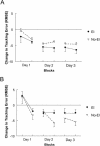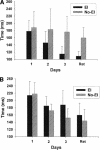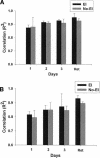Providing explicit information disrupts implicit motor learning after basal ganglia stroke
- PMID: 15286181
- PMCID: PMC498316
- DOI: 10.1101/lm.80104
Providing explicit information disrupts implicit motor learning after basal ganglia stroke
Abstract
Despite their purported neuroanatomic and functional isolation, empirical evidence suggests that sometimes conscious explicit processes can influence implicit motor skill learning. Our goal was to determine if the provision of explicit information affected implicit motor-sequence learning after damage to the basal ganglia. Individuals with stroke affecting the basal ganglia (BG) and healthy controls (HC) practiced a continuous implicit motor-sequencing task; half were provided with explicit information (EI) and half were not (No-EI). The focus of brain damage for both BG groups was in the putamen. All of the EI participants were at least explicitly aware of the repeating sequence. Across three days of practice, explicit information had a differential effect on the groups. Explicit information disrupted acquisition performance in participants with basal ganglia stroke but not healthy controls. By retention (day 4), a dissociation was apparent--explicit information hindered implicit learning in participants with basal ganglia lesions but aided healthy controls. It appears that after basal ganglia stroke explicit information is less helpful in the development of the motor plan than is discovering a motor solution using the implicit system alone. This may be due to the increased demand placed on working memory by explicit information. Thus, basal ganglia integrity may be a crucial factor in determining the efficacy of explicit information for implicit motor-sequence learning.
Figures





References
-
- Agid, Y. 1993. Mechanism of nerve-cell death in neurodegenerative disorders with a special reference to Parkinsons disease. Comptes Rendus des Seances de la Societe de Biologie et de Ses Filiales 18737 -46. - PubMed
-
- Alexander, G.E., DeLong, M.R., and Strick, P.L. 1986. Parallel organization of functionally segregated circuits linking basal ganglia and cortex. In Ann. Rev. Neurosci. (ed. W.M. Cowan), pp. 357-381. Society for Neuroscience, Washington, D.C. - PubMed
-
- Bliss, C.B. 1892. Investigations in reaction time and attention. Studies from the Yale Psychology Laboratory 1 1-55.
-
- Boder, D.P. 1935. The influence of concomitant activity and fatigue upon certain forms of reciprocal hand movements and its fundamental components. Comparative Psychology Monographs 11
-
- Boyd, L.A. and Winstein, C.J. 2001. Implicit motor-sequence learning in humans following unilateral stroke: The impact of practice and explicit knowledge. Neurosci. Lett. 298 65-69. - PubMed
Publication types
MeSH terms
LinkOut - more resources
Full Text Sources
Other Literature Sources
